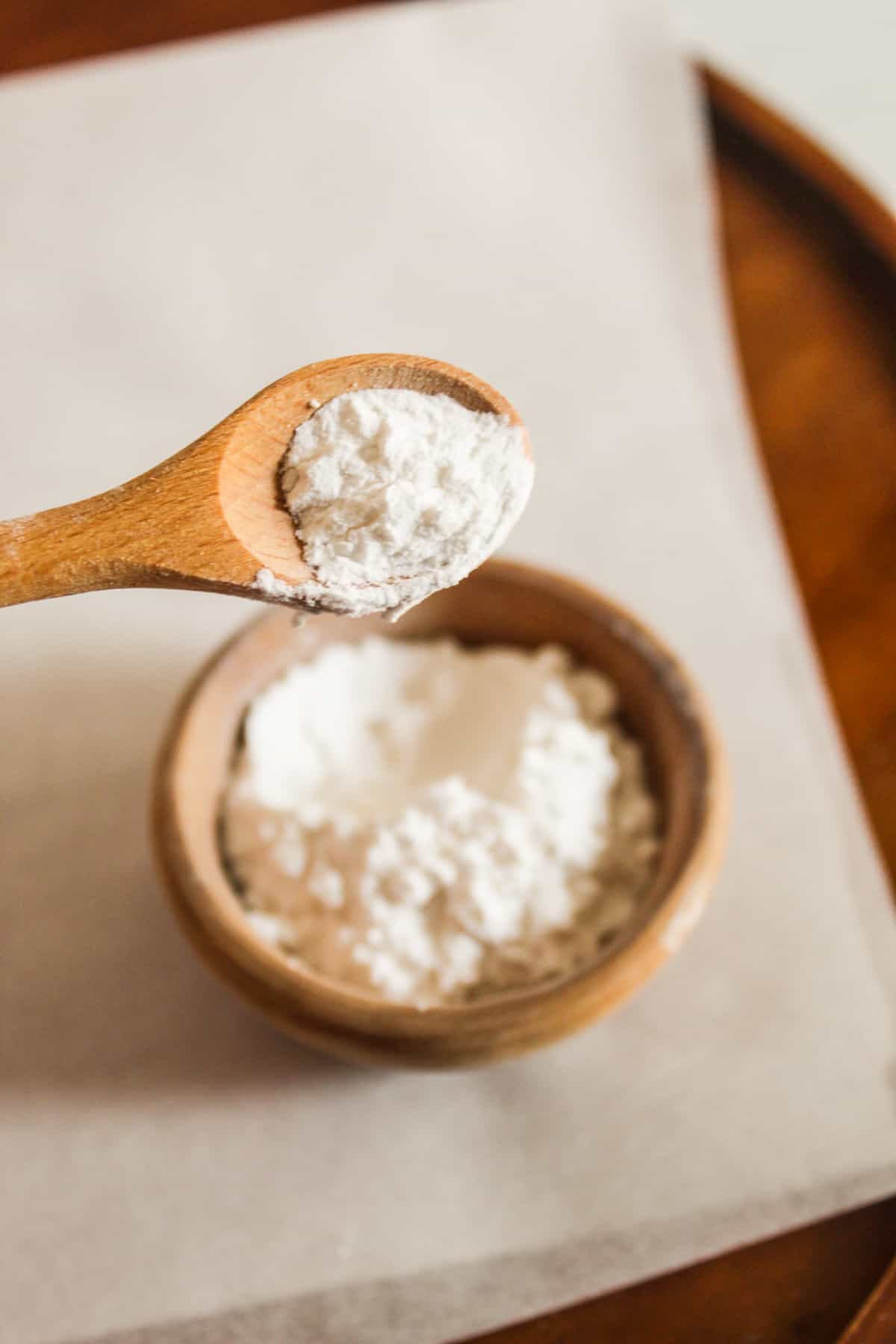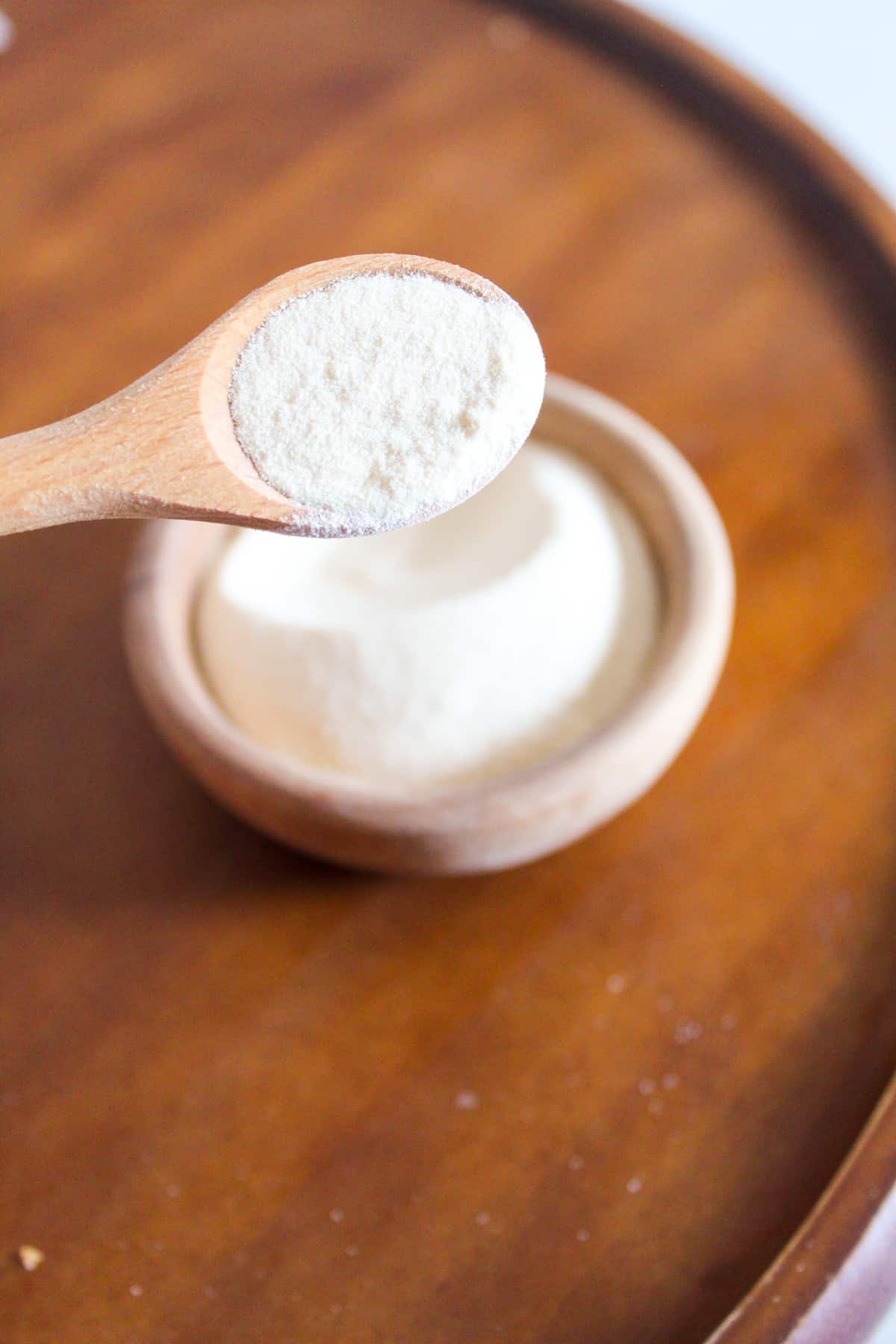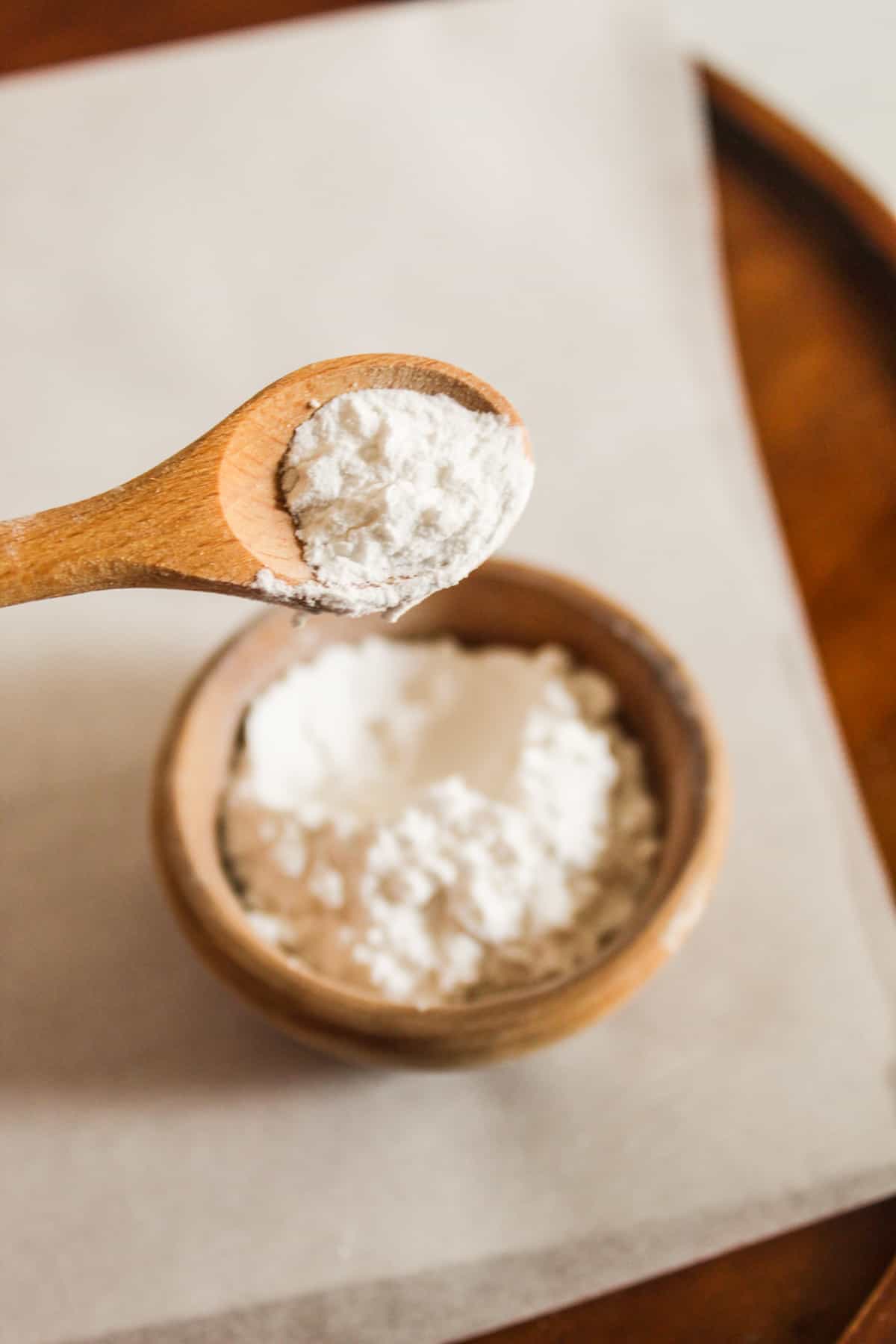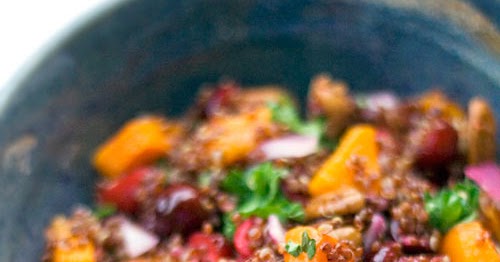These two ingredients are common in gluten-free baking, but how do they work, and which is the best? Find out everything you need to know about xanthan gum vs arrowroot powder to pick the right one every time!

If you’re on a gluten-free diet, you’re probably used to having a variety of unusual-sounding ingredients in your pantry. These two are very popular and are sometimes used for the same purposes, making it hard to know which one to use and when. Fortunately, there are a few key differences that make it easier to understand when and how to use each one!
Jump to:
Xanthan Gum vs Arrowroot Flour: Key Takeaways
Both xanthan gum and arrowroot bind ingredients together in soups, puddings, gluten-free recipes, and more, but they’re also quite different.
Xanthan gum is a fine white powder known for its exceptional thickening properties. It gels even in cold liquids and is a common ingredient in gluten-free baking. It’s also low in carbohydrates, making it a go-to in low-carb cooking.
Arrowroot flour is a soft, fluffy starch similar to cornstarch. It’s often added to gluten-free baking mixes and recipes to absorb moisture and give a light, fluffy texture. It’s also great for thickening sauces but must be cooked or heated first.
They can sometimes be used interchangeably, especially when thickening sauces or in baked goods. In these situations, use 1 teaspoon of xanthan gum for 1 tablespoon of arrowroot powder (or vice versa).
They are not interchangeable when arrowroot is used as flour (more than 1-2 tablespoons), as xanthan gum should only be used in very small amounts.
What is Xanthan Gum?
Xanthan gum is an excellent thickening agent made by fermenting usually corn or soy-derived sugar with bacteria. After the bacteria ferments, it is precipitated into a solution, then dried and ground into a fine powder you can add to soups, gluten-free bread, dairy-free ice cream, smoothies, and much more.
Like guar gum and other gums, xanthan gum is a phenomenal binding agent. It holds liquids and solids together incredibly well to prevent them from splitting. Xanthan gum turns into a gel-like substance that does not break down even if you cook or freeze the ingredients, which is why it is so prevalent in packaged foods and even toothpaste!
In gluten-free baking, xanthan gum offers the same glue-like texture of gluten without any wheat products. It’s the secret to gluten free breads that are soft and springy instead of dense and dry!
Plus, xanthan gum can be used hot or cold. Add it to gravies, smoothies, soups, cookies, cupcakes, muffins, and everything in between. It’s incredibly versatile, and a tiny bit goes a long way!
Best Xanthan Gum Substitutes
If you’re out of xanthan gum but still need your recipe to gel together, these are my favorite xanthan gum substitutes. Be sure to check out the full post to understand when and how to use them.
- Psyllium husk powder
- Ground chia seeds
- Ground flax seeds (flax meal)
- Unflavored gelatin
- Agar agar
- Konjac powder
- Whipped egg whites
- Arrowroot starch
- Pectin
- Cornstarch
More on each of these substitutes in this xanthan gum substitutes post.

What is Arrowroot Starch?
Arrowroot powder comes from the root of the arrowroot plant, which is dried, ground, and processed into a fine white powder. It is a great thickener, similar to cornstarch, and it’s lovely for thickening cooked sauces or puddings or giving gluten-free bakes a light, fluffy texture.
Since arrowroot is a starch and not a gum, it must be heated before eating. It is a popular ingredient in gluten-free flour blends alongside sweet rice flour and other starches to get the perfect soft texture.
Like cornstarch, arrowroot must be mixed into a small amount of water before adding it to soups or other sauces. Unlike cornstarch, which can give your pie fillings or gravies a cloudy appearance, arrowroot powder turns clear when heated for a smooth, glossy finish. However, it breaks down at high temperatures, so it can’t be cooked as hard or as long as cornstarch or xanthan gum.
Best Arrowroot Substitutes
If you’re out of arrowroot and need an alternative, these are the best arrowroot substitutes:
- Corn starch
- Tapioca starch
- Potato starch
Although xanthan gum can be used as a substitute for arrowroot, you often need much less (approximately 1 teaspoon xanthan gum per 1 Tablespoon arrowroot) and it is not always a good fit.
💭Which is Better: Arrowroot vs Xanthan Gum?
There are several layers to consider here! Although they are both popular in gluten-free baking and can even be used as substitutes for each other in some recipes, they are also quite different.
Nutritional Benefits
Since you use xanthan gum in such small quantities, it typically adds almost no nutritional value to your recipes.
One tablespoon of xanthan gum contains 30 calories, 7g of carbohydrates, 0g of fiber, 1g of protein, and 0g of fat.
Since arrowroot is a starch, it is high in carbohydrates and low in both protein and fat. One tablespoon of arrowroot powder has 35 calories, 8g of 0g of fiber, 0g of protein, and 0g of fat.
Although these stats look the same, you typically use ⅓ of a tablespoon (1 teaspoon) of xanthan gum per tablespoon of arrowroot, resulting in even fewer calories and carbohydrates per recipe.
Allergies
Arrowroot is an excellent substitute for cornstarch for people with corn allergies as it has no known allergens. It’s also low in FODMAPs and generally easy to digest.
Xanthan gum isn’t a known allergen, but many people are sensitive to it and experience digestive distress if they use more than 1 teaspoon per recipe.
Plus, xanthan gum must be fermented on sucrose, lactose, or glucose, and different companies use different materials as the substrate. Corn and soy are popular substrates for xanthan gum, which may be unsafe for people with those allergies. Make sure you read the packages clearly to purchase a product that is safe for you!
Uses
Xanthan gum has some unique properties that make it more useful than other gluten-free starches in some situations. That doesn’t mean it’s always the perfect solution, though!
Cold recipes: Xanthan gum can gel even in cold water, which is excellent for thickening salad dressings, smoothies, and more. Arrowroot can be used in cold recipes and thaws well, but it must be cooked first.
Baking: Both arrowroot and xanthan gum can be added as a powder to your gluten-free cakes, cookies, muffins, and more. Arrowroot gives your bakes a soft, tender texture that can be hard to achieve in gluten-free baking. It’s often included in prepackaged gluten-free flour blends for this reason.
Xanthan gum is generally used in very small amounts (approximately 1 tsp). You need far less xanthan gum than arrowroot, but it won’t offer the same texture and can’t be used as a flour like arrowroot or other starches.
Sauces, fillings, and soups: Both ingredients are an excellent choice for thickening hot recipes. Arrowroot should be mixed into a slurry with water before adding it to your sauce or filling. Xanthan gum does not need a slurry and will thicken whether the mixture is hot or cold.
Price
Xanthan gum is usually about $16-20/lb, but because you use so little at a time, one container will last a long time. Arrowroot usually costs between $5-10/lb.
Find both of these ingredients in my Amazon store.

Recipes Using Xanthan Gum or Arrowroot Starch
FAQs
Yes, you can often substitute xanthan gum for arrowroot powder. This gum is a great thickening agent and can help hold any batters or sauces together. Use 1 teaspoon of xanthan gum per 1 tablespoon of arrowroot starch. However, this only works for certain recipes. If you’re using more than a tablespoon or two of arrowroot in a recipe, you’ll be better off using another starch, like tapioca flour, instead of too much xanthan gum. I don’t recommend using more than 1 teaspoon of xanthan gum in your recipes.
Cornstarch is a great substitute for arrowroot powder! They’re both starches, have a very similar texture, and can be used interchangeably in recipes.
It depends. One main benefit of xanthan gum is its ability to gel ingredients together even when using such small amounts. It’s incredibly popular on the keto diet, but it must be used sparingly as it can cause digestive issues.
Arrowroot is much gentler on your stomach and gives your bakes a tender, fluffy texture, but it’s high in carbohydrates.
It’s not always either/or, though. Some recipes call for both arrowroot and xanthan gum, like this flaxseed bread. Xanthan gum can be too much more simple recipes like this pumpkin bread. Personally, I have been phasing xanthan gum out of my gluten-free recipes and using other binding agents instead.



